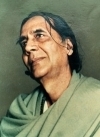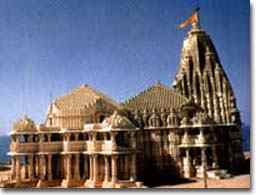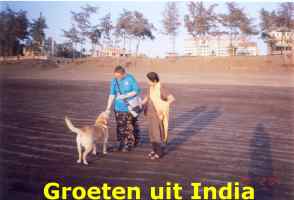|
The traffic
I went to India on my own and traveled mostly by train and part of my trip went by bus or rickshaw-taxi's
On the road you can meet the following:
- rickshaw-taxi's, a kind of motor bicycle that in this part of India totally superceded the old rickshaw . There are several models, all having one thing in common: they are always piling too many humans and things in them
- tractors in all sizes, states and years
- cars -and many taxi's -from incredibly old to the latest series
- busses from modern with airco till dilapidated wrecks
- lorries and trucks, beautifully painted
- thousands of motor bicycles with whole families on them (sometimes as many as 5!)
- carts pulled by water buffaloes, oxen or camels
- herdsmen with goats or cows
- thousands of travelers on foot
- thousands cows just walking, sitting or laying down
- millions of pigs on the loose
- thousands of dogs.
Roads often just sand but everything travels along them in all directions with lots of noise.
|
Junagadh
In Damodar Kund, near
Junagadh, the bones of Krishna were at last given to the water of the river. This is one of these rare, peaceful, quiet and clear places of my trip
The Asokan rock edicts carved in the Brahmi script on a large boulder is at the foot of the Gimar Hill, about 1 km east of the town of Junagadh. The emperor , instructed his people to be gentle with women, to be kind to animals, to give alms freely and to plant medicinal herbs. Asoka, described on the edicts as "the beloved of the Gods, of gracious countenance left a series of inscriptions on pillars and rocks were written in Prakit, using the Brahmi script. Fourteen of his edicts were engraved at the rock at Gimar, indicating that Kathiawad was an important Mauryan stronghold on the west coast of the Indian peninsula.
|
|
Dwarka
Dwarka,
which is derived from "Dwar" meaning a door was once the capital of Lord Krishna's empire and has a special importance as one of the major Hindu pilgrim places not because it is one amongst the four most important pilgrim places, but also it is one of India's seven oldest towns or Saptapuris.
Celebrated as Krishna's capital after his flight from Mathura, thousands come to observe Krishna's birthday, and also at Holi and Diwali.
The Dwarkadhish temple, in Dwarka is situated on the bank of river Gomti at the height of 40 feet
At the entrance to the temple I am recognized as a foreigner and taken out of the row of people to have my credentials checked. Vinod protests loudly, but I have my passport in a secret hiding place with me. I am presented with a form to complete by the temple 'Home Guard' and are only allowed in after indicating some level of commitment to Hinduism and to Krishna. Several choices given.
Because of this I am too late for the actual ceremony but a temple guard beckons and then a priestess takes me by the arm to lead me past all the people right up to the front where she positions me in front of a red curtain. The curtain opens and a boy is drumming behind it, more curtains open, the drumming becomes faster and cymbals and bells begin to ring. Behind the last curtain is the black statue of Krishna The drums beat faster and faster, people sing, clap their hands, stamp their feet and get exited. One of the women tells me to hide my head under a cloth and then some boys come forward. The are grinning as the open their drums and start throwing hands full of red, pink and white paint on the men and women gathered before them.
Of course it is Holi, this is a festival of colours - joy and happiness.
Slowly I walk outside, it is full moon. We leave the temple and find our way through the busy winding streets to our bus. One of the passengers looses his way and as his wife goes to seek him she is lost as well. It takes us almost two hours to find them again
A Holy French Lady
On our way from Porbandor to Junagadh, we stop at the ashram of Santoshgiri, the french "holy women ". I know her from a book Vinod once send me "Oceanside blues" by Druv Bhatt. She is a french lady who came here some 20 years ago and started an ashram where she helps local people. The bus stops at the Mocha Hanuman Shrine. This is a lovely place with white houses and surrounded by trees with a white chalked chapel in the centre.
We ask a woman if she is in the ashram and are told that at 08:00 she will be having tea with the people and at that moment SHE arrives, a women of about 50, dressed in white. Her eyes meet mine and lighten up for a moment and she invites us for tea under a banyan tree where cloth are being laid out to sit on and when she hears there are more people in the bus she sends some men to invite them all. She asks me to sit beside her and all the others at her feet and then she converses with us in English, Hindi and the local language, gives cookies to the women with children that come to see her to ask for a blessing (because of Holi they ask her to bless their firstborns) "India has lost contact with her spiritual roots" she tells me after listening to my story about the temples we have visited so far.
We have to leave.
“You are coming back"she says and I answer "yes"
Valsad
Himanshi, Vinod and I make daily walks at sunset, accompanied by the stray dogs and watched by the pigs
If we do not walk in the neighbourhood we make a long walk on the beach and Himanshi and I will sit down in the black sand and watch the sun set and talk sometimes
It is peaceful and very quiet. The swallows call to each other above our heads and Vinod walks backwards and forwards as does Sonou. Not till the sun has totally disappeared into the sea we leave for home.
|
A holy man
Vinod's guru Makarand Dave is a poet who 30 years ago initiated the building of the ashram Nandigram with a group of Indian intellectuals who wanted to do something for India and who - like Gandhi - thought that the strength of India was in the village and not in the cities From the ashram they provided help in the form of teaching, health, food, ecological agriculture, religion to the inhabitants of the region. From Mumbai once a month a team of medical specialists and doctors arrive for operations in the small hospital.
When we arrive it appears this same day the doctors have come from Mumbai and so within a couple of hours I meet many lovely people.
Makarand is 93. Vinod has not seen him for a year because he is bedridden and generally people are no longer allowed to visit hum but after I have been introduced to Kundanika Kapadia, his wife and also a renowned Gujarati novelist and editor, she comes to me a little later and tells me that Makarand wants to meet me. He is an extremely old man with clear eyes but a weak body and when I enter his room he is in bed, his body kept up by cushions and surrounded by 3 men to help him. He invites me to sit down and then he talks to me about his work. Only two volumes have been translated into English. Finally he talks about LOVE in beautiful language. His words transgress the body-mind-self boundaries and my heart is reached and touched by him. He talks straight to my soul and tears slide down my cheeks.
 Shri Makarand Dave, also lovingly known as a saint poet, ”Sai Makarand”, took his last breath on January 31st, 2005 at 5.30 am IST at his Nandigram residence.
In the presence of many loving friends his holy body was cremated in Nandigram, on February 1st, 2005 at a place pre-designated by him. Shri Makarand Dave, also lovingly known as a saint poet, ”Sai Makarand”, took his last breath on January 31st, 2005 at 5.30 am IST at his Nandigram residence.
In the presence of many loving friends his holy body was cremated in Nandigram, on February 1st, 2005 at a place pre-designated by him.
I am being shown around the ashram, join the morning prayers at the school, driven over the Neem plantation to the cows and have to visit all the holy places of the ashram. I ask how these holy places where they have build small temples, were found or discovered and am told that Makarand decided this matter. He could see what was at certain places and what could "grow" there. We decide that I shall stay here a couple of days
Nandigram
I am invited to "join the program" but Kundanika Kapadia declares that we cannot leave before 16:00 because it is too hot (40 C) for me to travel and I should rest. Then at four o' clock we leave the Ashram with the jeep to go to a small village in the mountains to teach the children. We are with two women and two men. One of the women is 83 years old, there is a young women who is still a student and whose mother is the cook in the ashram. We pick up two more women-teachers in the town on the way.
We drive for an hour with the jeep, first on paved roads, then on small sand roads winding through the hills in the jungle. The people here are darker than my friends and are called "tribal's" by them. The houses in which they live are made from unbaked clay with thatched or panned roofs, I imagine rather like the houses in my village a 1000 years ago.
 This special village has a school but the people do not like the government and have thrown out the teacher. There is a very young woman from the next village teaching the children and since some time the Nandigram teachers come there to teach This special village has a school but the people do not like the government and have thrown out the teacher. There is a very young woman from the next village teaching the children and since some time the Nandigram teachers come there to teach
Nandigram also dug a large well, 25 feet deep to the people need not walk so far to reach drinking water.
Jalamsang -one of the men who originates from a similar village- comes to take me from the classroom to show me around and then asks me to visit a family where they serve me water and cashew-fruit. When I ask the family if I may take their photograph they want to change into their best clothes which takes a while and results in a very "stiff" photo.
Back in the classroom they sing and dance for me. and in the next couple of hours the class gets fuller and fuller. I realize more children are coming because at the end of the lessons all children will receive some hands full of salted nuts and seeds.
Three hours later on our way home we stop at a small temple. The sun has just set and it is too dark to see clearly except that this temple is made from wood and leaves. Candles burn inside on the floor and it is dedicated to Krishna, but the temple did not want to stand after it was made so now it is a simple structure of bark and sticks.I ring the bell, meditate and it feels good.
At 07:00 in the morning there is a service in one of the temples and half an hour later we greet the Sun God outside with a group of people, standing in he rising sun and looking to the east. Later I take a lonely walk to visit all the small temples of Nandigram, sit there and meditate. I also meet a leguane and a snake.
|
| Somnath
The Somnath Temple, a major Hindu pilgrimage centre, is said to have been Pre built out of gold by Somraj, the Moon God and subsequently in silver, wood and stone. In keeping with the legend the stone facade appears golden at sunset. Mahmud of Ghazni plundered it and removed the gates in 1024. Destroyed by successive Muslim invaders, it was rebuilt each time on the same spot. The final reconstruction did not take place until 1950 and is still going on. Dedicated to Siva, it has one of the 12 sacred jyotirlingas (Puja at 0700, 1200, 1900.)
 The temple is on the beach and it is a pleasure to walk around. We come in time for Darshan and our passengers ready themselves for the offerings and the service and then Vinod "looses" me for a while as I do not walk behind him as he moves to the west-side of the building. The temple is on the beach and it is a pleasure to walk around. We come in time for Darshan and our passengers ready themselves for the offerings and the service and then Vinod "looses" me for a while as I do not walk behind him as he moves to the west-side of the building.
Drumming, music, singing, clapping of hands. The sound is overwhelming. I sit down alone, at the east side on a small staircase next to a pillar and enjoy the atmosphere, watch the priest going around with fire and giving blessings to the four corners of the wind.
|
Bhavnagar. Part of Vinod's family lives here and I am staying with his eldest brother Mahendra. That the evening, as we are sitting on the terrace, Mahendra translates some Indian literature to me. Then some young girls come to visit him to ask for information and I enjoy being with these sensitive and intelligent people. Later I read to him the poem "Children" from the " Prophet" from Kahlil Gibran and he is so touched that he takes a pile of books from his library to take home with me.
With Vinod I visit the museum, where he wants to find a man in the library who has helped him with his fathers books. This man is so honoured that he tries to kiss Vinod's feet and then takes us into the library to meet all the other librarians. Of course we have to drink tea with them.
In the museum there is a good exposition on Gujarat and the exhibition on Gandhi is the best I have seen in India.
|



 Shri Makarand Dave, also lovingly known as a saint poet, ”Sai Makarand”, took his last breath on January 31st, 2005 at 5.30 am IST at his Nandigram residence.
In the presence of many loving friends his holy body was cremated in Nandigram, on February 1st, 2005 at a place pre-designated by him.
Shri Makarand Dave, also lovingly known as a saint poet, ”Sai Makarand”, took his last breath on January 31st, 2005 at 5.30 am IST at his Nandigram residence.
In the presence of many loving friends his holy body was cremated in Nandigram, on February 1st, 2005 at a place pre-designated by him.  This special village has a school but the people do not like the government and have thrown out the teacher. There is a very young woman from the next village teaching the children and since some time the Nandigram teachers come there to teach
This special village has a school but the people do not like the government and have thrown out the teacher. There is a very young woman from the next village teaching the children and since some time the Nandigram teachers come there to teach The temple is on the beach and it is a pleasure to walk around. We come in time for Darshan and our passengers ready themselves for the offerings and the service and then Vinod "looses" me for a while as I do not walk behind him as he moves to the west-side of the building.
The temple is on the beach and it is a pleasure to walk around. We come in time for Darshan and our passengers ready themselves for the offerings and the service and then Vinod "looses" me for a while as I do not walk behind him as he moves to the west-side of the building.